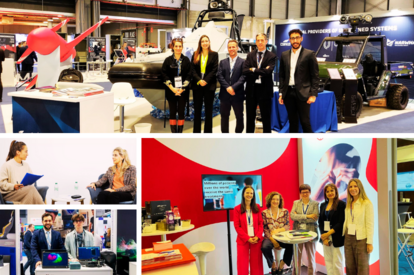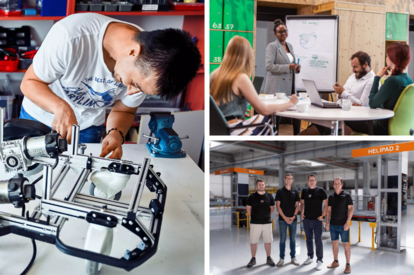
Artificial intelligence (AI) can be a powerful tool for small businesses, helping to automate tasks, boost customer satisfaction, and drive faster growth. Curious to see what AI can do for your company? Check out our 7-step guide to make AI part of your operations.
AI helps businesses run more smoothly in many ways. It makes companies more flexible, so they can quickly adjust to changes in the market. By automating repetitive tasks, AI also speeds things up, helping teams make decisions faster and deliver results more quickly. This automation makes it easier to scale, as AI can handle more work without losing quality. When it comes to decision-making, AI provides useful data and insights that help teams make smarter choices faster. Plus, it improves personalisation by analysing customer data to create more tailored experiences.
But AI isn’t a plug and play technology. To get the most out of it, you need a clear plan. That means setting clear goals, choosing the right tools, and understanding how to use AI effectively. Here’s a quick 7-step guide to help you bring AI into your business:
1. Identify key areas for AI integration
Start by finding areas where AI can make the biggest impact. For example, AI can speed up slow and cumbersome processes, like Uber’s use of it to match riders with drivers in real-time, cut wait times, and optimise routes.
Businesses that place a premium on personalisation, like Amazon, Netflix, and Spotify, rely on AI to analyse customer behavior and suggest products or content that match individual preferences. AI also helps with decision-making by quickly sifting through huge amounts of data to spot trends and patterns that humans might miss. For example, retailers like Target and Walmart use it to predict inventory needs and streamine their supply chains.
2. Set clear objectives
Once you've figured out where you can improve, the next step is to set clear goals for using AI. Use the SMART framework to make sure your goals are specific, measurable, achievable, relevant, and time-bound. For example, instead of just saying you want to "improve efficiency," set a goal like "reduce customer service response time by 30% in 6 months using AI chatbots for quick questions."
After setting your goals, keep an eye on your progress. Break your main goal into smaller, easier steps. For instance, if you're working on faster response times, check every week to see if they’re improving. Track customer satisfaction and how well the AI handles common questions, so you can spot any issues early and make adjustments. This way, you’ll stay on track to reach your goals.
3. Redesign operations for AI
To get the most out of AI, you'll need to rethink your workflows. Simply adding AI to a clunky process won’t do much; instead, focus on using it to speed up decision-making and streamline operations, while leaving tasks that require emotional intelligence or creativity to humans. Take Siemens, for example: they use AI to match candidates to jobs based on skills, but people still handle the interviews and make the final hiring decisions. Similarly, AI chatbots like Zendesk can manage up to 70% of routine customer service requests, freeing up teams to focus on more complex issues that need a personal touch.
Another important part of making AI work is gathering feedback. Once AI is in place, regularly check in with your team and customers to see how it’s performing. For example, if you’re using AI to personalise marketing, ask customers if they find the suggestions helpful. This feedback can offer valuable insights and help you improve your AI systems.
4. Choose the right AI tools
Once you’ve redesigned your processes to include AI, the next step is picking the right tools. Start by selecting tools that align with your goals. For example, if you want to improve customer interactions, Intercom’s AI chatbots can help manage queries and provide personalised support.
Next, decide if you need off-the-shelf tools or custom solutions. Ready-made options, like Mailchimp for email automation or Salesforce for customer relationship management, are easy to set up and work well for common needs. But if you have more specific requirements, like a custom inventory system, a tailor-made AI tool might be a better fit.
Finally, make sure the AI tools you choose integrate smoothly with your current systems and can scale as your business grows. HubSpot’s AI tools, for example, work well with many different platforms.
5. Pilot and scale gradually
Before rolling out AI across your business, start small by testing it in one area. For example, you could introduce an AI chatbot to handle customer questions on your website. This lets you experiment with AI without investing too many resources upfront.
Once your pilot project is up and running, monitor its performance. Track data to see if it’s meeting your goals, like faster response times or improved customer satisfaction. Use this feedback to tweak the AI, such as adjusting chatbot responses or refining algorithms to improve the answers it provides.
If the pilot is successful, gradually expand the AI tool to other areas of your business. Start by applying it to similar tasks or departments. For example, if the chatbot performs well on your website, consider using it for social media customer support next. Keep monitoring and adjusting as you scale to ensure consistent performance and improvements.
6. Train and engage employees
Your AI’s success depends on the people behind it. Start by putting together a strong team that includes AI specialists to build and improve models, IT experts to ensure smooth integration, business analysts to spot AI opportunities, and project managers to keep everything on track.
Help your team see AI as a tool that supports them, not something that replaces them. Show how automating routine tasks, like data entry, can free up their time for more meaningful, creative work. Get them involved early by asking for their input on where AI could be useful.
Make sure everyone gets the right training for their role, and keep offering support as they learn. Big companies like IBM, Google, and Microsoft do this well, regularly investing in AI training to help their teams grow with the tech. This boosts skills and builds a culture that’s open to innovation and change.
7. Work with a trusted partner
Partnering with an AI expert or vendor can make your AI integration easier and faster. First, think about what you need. For example, if you want to improve customer service, decide if a custom chatbot or a ready-made solution fits your goals better.
Next, look for a partner with the right experience and a strong track record. Check out case studies in your industry to see how they’ve helped others. Once you’ve found the right fit, set clear goals, timelines, and ways to measure success. Keep the lines of communication open with regular check-ins and feedback to stay on track.
The Enterprise Europe Network is here to make your AI journey easier. Our business advisers can connect you with trusted AI experts through networking events like the Applied AI Conference and the DEICy 2024. For example, we've helped companies like Phytowelt Green Technologies in Germany team up with a Dutch AI provider to develop a new bio-fermentation product for food and beauty. We can also guide you in choosing the best AI tools and securing funding, just like we did for My Shoefinder, a small company building an AI-powered shoe sizing tool. Plus, we'll keep you updated on the latest AI technologies and trends, so you stay ahead of the curve. Want to see how AI can work for your business? Get in touch with your local Network contact point today.
Benno Weissner is a Consultant and Project Manager at ZENIT, the Centre for Innovation and Technology in North Rhine-Westphalia. Since 2023, he has also chaired the Enterprise Europe Network’s expert group on digitalisation.
The article was co-authored by Ruxandra-Laura Bosilca, PhD, Social Media and Community Manager for Enterprise Europe Network.
Related articles

In a world of saturated markets and shrinking attention spans, innovative SMEs must go beyond great products: they need smart, strategic communication to succeed globally. Discover five powerful tips...

Starting a business on a tight budget? You don’t need a huge marketing budget to see real results. In this article, we’ll share 4 affordable marketing strategies for small businesses, showing you how...

Is Texas your next big opportunity? You’re probably thinking of sizzling fajitas, rugged cowboys, or the sweet sound of Willie Nelson strumming his guitar. Well, Texas has all of that, but it’s also...

Start-ups need funding, mentorship, and networks to scale. Big companies are looking for fresh ideas, disruptive tech, and faster ways to stay ahead. When they join forces, both sides win. Keep...
